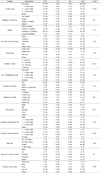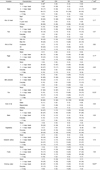1. Bray GA. NIH publication No., pp. 79-359. Obesity in America. 1979. Maryland. USA: 1–19.
2. Byun KW, Choi HM. Serum Lipid and Lipoprotein Levels of College Students aged 18 to 26 Years. Korean Journal of Lipidology. 1994. 4:29–40.
3. Chang HS, Kim MR. A study on the anthropometry and health-related lifestyle habits of women college students in kunsan. Korean Journal of Community Nutrition. 2003. 8:526–537.
4. Chang NS. Changes in dietary habits of adults with middle and upper income levels in Seoul. Korean Journal of Nutrition. 1996. 29:547–558.
5. Cho HS. A study on college students dietary behavior and consciousness of Korean Traditional food in Junlanamdo. Korean Journal of Dietary Culture. 1997. 12:301–308.
6. Choi MK, Jun YS, Kim AJ. A survey on dietary behavior and nutrient intake of smoking male college students in Chungnam area. Korean Journal of Dietary Association. 2001. 7:248–257.
7. Chung SH, Chang KJ. A comparison between food and nutrition major, and non-major female university students in terms of their serum iron. Korean Journal of Nutrition. 2002. 35:952–961.
8. Han MJ, Cho HA. Dietary habit and perceived stree of college students in Seoul area. Korean Journal of Dietary Culture. 1998. 13:317–325.
9. Hermann JR. Effect of cooperative extension nutrition and exercise program for older adults on nutrition knowledge, dietary intake, anthropometric measurements & serum lipids. J Nutr Educ. 1990. 22:271–274.

10. Hong SM, Bak KJ, Jung SH, Oh KW, Hong YA. A study on nutrient intakes and hematological status of female college students of ulsan city -1. emphasis on serum lipids-. Korean Journal of Nutrition. 1993. 26:338–346.
11. Hyun WJ. The relationship between obesity, lifestyle, and dietary intake and serum lipid level in male university students. Korean Journal of Community Nutrition. 2001. 6:162–171.
12. Kang WC. Changing Patterns of Disease in Korea. Korean Journal of Nutrition. 1998. 21:139–145.
13. Kang YJ, Hong CH, Hong YJ. The prevalence of childhood and adolescent obesity over the last 18 years in Seoul area. Korean Journal of Nutrition. 1997. 30:832–839.
14. Kim AJ, Chang OJ, Kim HK, Kim SK, Kim JH, Chi HY, Kim SY. Relationship of serum chrominum with serum lipids and blood glucose level in rural college Women. Korean Journal of Community Nutrition. 1998. 31:977–985.
15. Kim BR, Han YB, Chang UJ. A study on the attitude toward control, diet behavior and food habits of college students. Korean Journal of Community Nutrition. 1997. 2:530–538.
16. Kim JH, Ahn HJ, Lee SE. Body composition, food intake and clinical blood indices of female college students. Korean Journal of Community Nutrition. 2003. 8:977–985.
17. Kim KH. A Study of Dietary Habits, the Nutritional Knowledge and Consumption Patterns of Convenience Foods of University Students in the Gwangju Area. Korean Journal of Community Nutrition. 2003. 8:181–191.
18. Kim KK, Kang HJ, Kim KW. A study of weight reduction attempt, psychosocial status, nutrition behavior and related factors among females university students. Korean Journal of Community Nutrition. 1999. 1:108–118.
19. Kim KN, Lee KS. Nutrition knowledge, dietary attitudes, and food behaviors of college students. Korean Journal of Community Nutrition. 1996. 1:89–99.
20. Kim MK. Serum Lapids by Gender, Age and Lifestyle inKorean Adults. Korean Journal of Community Nutrition. 2000. 5:109–119.
21. Kim OH, Kim JH. Food Intake and Clinical Blood Indices of Female College Students by Body Mass Index. Korean Journal of Community Nutrition. 2006. 11:307–316.
22. Kim YH, Paik HY. Relationship between dietary fatty acids, plasma lipids, and fatty acid compositions of plasma and RBC in young korean females. Korean Journal of Nutrition. 1994. 27:109–117.
23. Korean Nutrition Society. Dietary Reference Intakes for Koreans. 2005. Seoul. Republic of Korea: Hanareum Printing.
24. Korean Statistical Information Homepage. Accessed on 02/23/2007.
www.nso.go.kr.
25. Korean Society for the Study of Obesity. The Asia-pacific perspective: Redefining obesity and it's treatment. 2000. Seoul. Republic of Korea:
26. Lee HB, Yu YS. A study on lunch meal practice of the college students in Seoul area. Korean Journal of Dietary Culture. 1995. 10:147–154.
27. Lee HS, Lee JA, Paik JJ. A study of food habits, physical status and related of college students in Chuncheon. Korean Journal of Community Nutrition. 1998. 3:34–43.
28. Lee JH, Chang KJ. Regional differences in food intake and diversity among Korean college students of a nutrition education course through the internet. Korean Journal of Community Nutrition. 2002. 8:41–52.
29. Lee JH, Chang KJ. The Relationship between the Diversity of Food Intake and Nutritient Intake among Korean College Students Participating in a Nutrition Education Class via the Internet. Korean Journal of Community Nutrition. 2003. 8:689–698.
30. Lee Ms, Lee JW, Woo MK. Study on the factors influencing food consumption by food frequency questionnaire of universitystudents in Taejon. Korean Journal of Community Nutrition. 2001. 6:172–181.
31. Lee MS, Woo MK. Changes in food habit, nutritional knowledge and nutrition attitude of university students during nutrition course. Korean Journal of Nutrition. 1999. 32:735–745.
32. Lee MS, Woo MK. Differences in the Dietary and Health-Related Habits and Quality of Diet in University Students Living in Daejeon. Korean Journal of Community Nutrition. 2003. 8:33–40.
33. Lee KA. A comparison of eating and general health practices to the degree of health consciousness in Pusan college students. Korean Journal of Food and Nutrition. 1999. 28:732–746.
34. Lee YN, Lee JS, Ko YM, Woo JS, Kim BH, Choi HM. Study on the food habits of college students by residents by residences. Korean Journal of Community Nutrition. 1996. 1:189–200.
35. Mun SJ, Yoon HJ, Kim JH, Lee YJ. A study on the perception and consumption pattern of convenience foods by Korean college students. Korean Journal of Dietary Culture. 1998. 13:227–239.
36. Na HB, Kim HJ, Choi KS. Correlation between BMI and Physical Fitness of College Women in Seoul. Korean Journal of Community Nutrition. 2003. 5:29–36.
37. National Reserch Council. Dietary reference Intakes for Calcium, Phosphorus, Magnesium, Vitamin D, and Fluoride. 1997. Washington, DC. USA: National Academy Press.
38. Ministry of Health and Welfare. Report on 2001 National Health and Nutrition Survey. 2002. USA:
39. Park HS, Lee HO, Sung CJ. Body image, eating problems and dietary intakes among female college students in urban area of Korea. Korean Journal of Community Nutrition. 1997. 2:505–514.
40. Park MS, Kim SA. Effect of nutrition education on improving diet behavior of university students. Korean Journal of Community Nutrition. 2005. 10:189–195.
41. Rogers AE, Conner MW. Alcohol and cancer. Adv Exp Med Biol. 1986. 206:473–495.

42. Ryu HK, Yoon JS. A study of perception about body image in adolescent females. Korean Journal of Community Nutrition. 1999. 4:554–560.
43. Salaspuro M. Nutrient intake and nutritional status in alcoholics. Alcohol Alcohol. 1993. 28:85–88.
44. Shim JE, Paik HY, Moon HK, Kim YO. Comparative Analysis and Evaluation of Dietary Intakes of Koreans by Age Groups: (1) Nutrient Intakes. Korean Journal of Nutrition. 2001. 34:554–567.
45. Slette PL, Story M. Child nutrition: Objectives for the decade. J Am Diet Assoc. 1991. 91:665–668.

46. Wattigney WA, Harsha DW, Srinivassan SR, Webber LS, Berenson GS. Increasing impact of obesity on serum lipids and lipoprotein in young adults. the bopgalusa heart study. Arch Intern Med. 1991. 151:2017–2022.

47. WHO (World Health Organization). Technical Report Series 843. Assessment of Fracture Risk and its Application to screening for Postmenopausal Oteoporosis. 1994. Geneva. Switzerland: World Health Organization.






 PDF
PDF ePub
ePub Citation
Citation Print
Print






 XML Download
XML Download